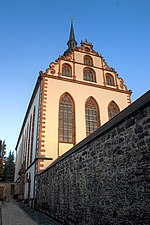Fulda Cathedral
1712 establishments in the Holy Roman Empire18th-century Roman Catholic church buildings in GermanyBaroque architecture in GermanyBuildings and structures in Fulda (district)Burial sites of the Conradines ... and 6 more
Church buildings with domesFuldaFulda CathedralRoman Catholic cathedrals in HesseRoman Catholic churches completed in 1712Roman Catholic churches in Hesse

Fulda Cathedral (German: Fuldaer Dom, also Sankt Salvator) is the former abbey church of Fulda Abbey and the burial place of Saint Boniface. Since 1752 it has also been the cathedral of the Diocese of Fulda, of which the Prince-Abbots of Fulda were created bishops. The abbey was dissolved in 1802 but the diocese and its cathedral have continued. The dedication is to Christ the Saviour (Latin: Salvator). The cathedral constitutes the high point of the Baroque district of Fulda, and is a symbol of the town.
Excerpt from the Wikipedia article Fulda Cathedral (License: CC BY-SA 3.0, Authors, Images).Fulda Cathedral
Domplatz,
Geographical coordinates (GPS) Address External links Nearby Places Show on map
Geographical coordinates (GPS)
| Latitude | Longitude |
|---|---|
| N 50.554 ° | E 9.6718 ° |
Address
Dom St. Salvator
Domplatz 1
36037
Hesse, Germany
Open on Google Maps








